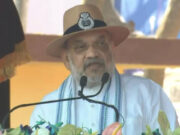
NEW DELHI: In a bold scientific endeavor, Nasa‘s WB-57 jets are set to chase the upcoming total solar eclipse, offering scientists an unparalleled vantage point for observation. Flying at altitudes well above commercial aircraft, these jets can soar above clouds, eliminating the risk of visibility issues due to inclement weather. This advantage is crucial, as it guarantees an unobstructed view of the eclipse, a phenomenon that has historically been a catalyst for numerous scientific breakthroughs.
The high altitude of the WB-57s not only ensures clear skies but also places the aircraft above most of Earth’s atmosphere.This position is optimal for capturing crisper images and observing wavelengths of light, like infrared, that are otherwise absorbed before reaching the ground. The significance of this capability cannot be overstated, as it allows for the collection of data that is essential for a wide range of scientific research.
Furthermore, the WB-57s’ impressive speed of 460 miles per hour enables these jets to extend their observation time within the Moon’s shadow by approximately 25 percent compared to observations from the ground. While observers on Earth will experience the eclipse for no more than four and a half minutes, the crews aboard the WB-57s will witness this celestial event for over six minutes and 22 seconds. This extended duration is vital for conducting various scientific experiments funded by Nasa, aimed at making crucial measurements during the eclipse.
Nasa’s deployment of the WB-57 jets underscores the agency’s commitment to leveraging innovative approaches to advance our understanding of the cosmos. By pursuing the total solar eclipse from such unique perspectives, scientists hope to uncover new insights into the solar system’s workings, continuing the legacy of discovery that eclipses have historically enabled.
How does Nasa’s WB-57 jet extend the duration of eclipse observation?
Nasa’s WB-57 jet extends the duration of eclipse observation by leveraging its high-speed flight capabilities. Flying at speeds of 460 miles per hour, the WB-57 can keep pace with the Moon’s shadow as it moves across the Earth’s surface during a total solar eclipse. This ability to fly within the Moon’s shadow for a longer period allows the aircraft to experience and observe the eclipse for about 25 percent longer than is possible from any fixed point on the ground.
While the total solar eclipse lasts no more than four and a half minutes at any given location on Earth, the WB-57’s rapid flight extends this observation window to over six minutes and 22 seconds. This extended observation time is crucial for conducting scientific experiments and measurements that require more than just a brief glimpse of the eclipse. The additional time in the shadow of the Moon provides scientists aboard the WB-57 with a unique opportunity to capture more data and clearer images of the eclipse, including infrared wavelengths that are not visible from the ground due to atmospheric interference.
The high altitude of the WB-57s not only ensures clear skies but also places the aircraft above most of Earth’s atmosphere.This position is optimal for capturing crisper images and observing wavelengths of light, like infrared, that are otherwise absorbed before reaching the ground. The significance of this capability cannot be overstated, as it allows for the collection of data that is essential for a wide range of scientific research.
Furthermore, the WB-57s’ impressive speed of 460 miles per hour enables these jets to extend their observation time within the Moon’s shadow by approximately 25 percent compared to observations from the ground. While observers on Earth will experience the eclipse for no more than four and a half minutes, the crews aboard the WB-57s will witness this celestial event for over six minutes and 22 seconds. This extended duration is vital for conducting various scientific experiments funded by Nasa, aimed at making crucial measurements during the eclipse.
Nasa’s deployment of the WB-57 jets underscores the agency’s commitment to leveraging innovative approaches to advance our understanding of the cosmos. By pursuing the total solar eclipse from such unique perspectives, scientists hope to uncover new insights into the solar system’s workings, continuing the legacy of discovery that eclipses have historically enabled.
How does Nasa’s WB-57 jet extend the duration of eclipse observation?
Nasa’s WB-57 jet extends the duration of eclipse observation by leveraging its high-speed flight capabilities. Flying at speeds of 460 miles per hour, the WB-57 can keep pace with the Moon’s shadow as it moves across the Earth’s surface during a total solar eclipse. This ability to fly within the Moon’s shadow for a longer period allows the aircraft to experience and observe the eclipse for about 25 percent longer than is possible from any fixed point on the ground.
While the total solar eclipse lasts no more than four and a half minutes at any given location on Earth, the WB-57’s rapid flight extends this observation window to over six minutes and 22 seconds. This extended observation time is crucial for conducting scientific experiments and measurements that require more than just a brief glimpse of the eclipse. The additional time in the shadow of the Moon provides scientists aboard the WB-57 with a unique opportunity to capture more data and clearer images of the eclipse, including infrared wavelengths that are not visible from the ground due to atmospheric interference.




































